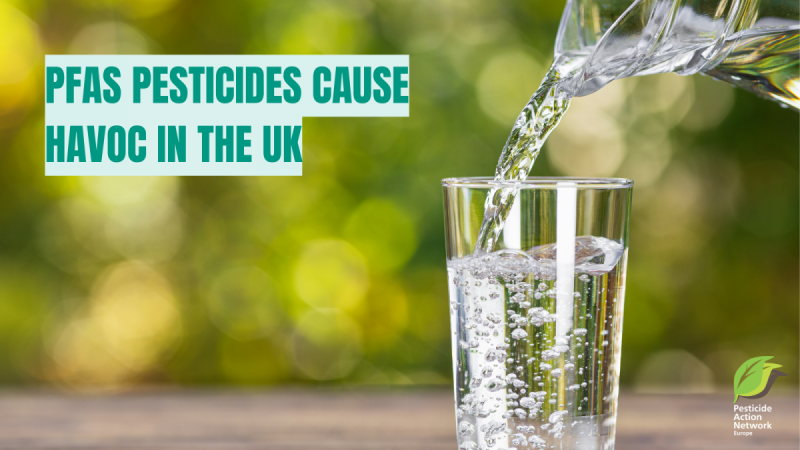PAN Europe recently revealed that PFAS pesticides residues are found in many fruits and vegetables. We also showed that one of their breakdown products TFA – a small and very soluble and mobile PFAS – is omnipresent in surface, ground and drinking water all over Europe. Our colleagues from PAN UK and FIDRA now show that the UK is facing the same pollution problem. These forever chemicals are deliberately sprayed on food and fields and their use is increasing. Not only are they persistent but they also have toxic properties. Farmers are completely unaware they’re using PFAS: it is not written on the label. We now know that these substances are far from harmless. There is an urgent need to address this problem, which is already becoming immense.
The Scottish organisation FIDRA shows in their “PFAS Active Substances in the UK” (1) that:
- PFAS pesticides are used across all agricultural sectors in the UK
- In 2022, PFAS pesticides were sprayed on the equivalent of more than 10.6 million hectares of arable crops
- PFAS pesticides represented 16% of the most used pesticides within the arable sector in 2022
- The use of six of the most used PFAS pesticides significantly increased between 2020 and 2022
We see similar results in the EU. In our November 2023 report, we revealed that 37 active ingredients authorised for pesticide use in the European Union are PFAS. This is 16% of all pesticide active ingredients. These are deliberately sprayed across EU agricultural fields, contaminating our food, water, and the environment. Farmers are not aware, because producers don’t mention the PFAS risks on the label. They hide behind the authorisation given by the EU and national authorities.
An analysis of the French sales data for these substances raises alarms about the rising popularity of PFAS pesticides. Between 2008 and 2021, their sales in France increased dramatically, tripling in magnitude. This indicates massive spraying of PFAS pesticides in open fields, leading to significant exposure of citizens and the environment. We see the same rise in sales figures in Germany.
Residues in food
New research reveals that many common UK food items contain PFAS pesticides. PAN UK analysed the latest results from the UK government’s residue testing programme, finding that ten different PFAS pesticides were present in spices and a range of fruit and vegetables including grapes, cherries, spinach and tomatoes. Strawberries were found to be the worst offenders, with 95% of the 120 samples tested by the government in 2022 containing PFAS pesticides. (3)
These are similar results to those in our February Toxic Harvest report. We made an analysis of official data of pesticide residues in food in Member States. The number of European fruit and vegetables with detected PFAS pesticide residues has nearly tripled between 2011 and 2021, with a growth rate of 220% for fruit and of 274% for vegetables. (4) However, the PFAS pollution of UK strawberries is even more extreme.
Notes:
(1) PFAS Active Substances in UK Pesticides, FIDRA, July 2024
(2) Europe's Toxic Harvest: Unmasking PFAS Pesticides Authorised in Europe, PAN Europe and Générations Futures, November 2023
(3) ‘Forever chemicals’ found in UK food, PAN UK, April 2024
(4) Report “Europe Toxic Harvest: Unmasking PFAS pesticides authorised in Europe”, PAN Europe and members, February 2024
